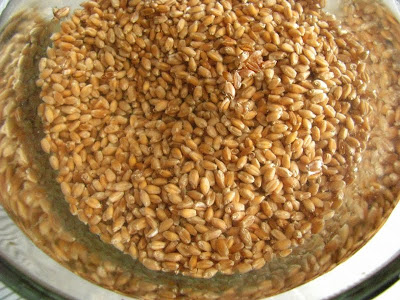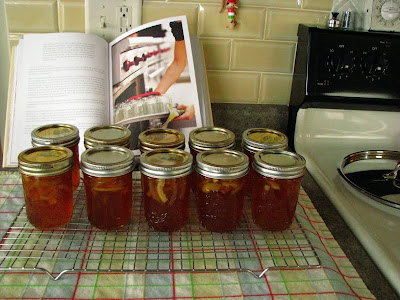Saturday is a leisurely day for many people, although I feel privileged to lead a life mostly comprised of Saturdays so to speak. Lo mentioned something about sourdough English muffins yesterday, and here on my table for a shared Saturday breakfast are gorgeous sourdough English muffins. Let me tell you, sourdough fiends, they are amazing.

Food classified under the terms of traditional food, nutrient rich diet, or the Nourishing Traditions diet seems to be my reading and obsession focus as of late. Tiny whispers of things like brined nuts that entered my thoughts via Food 52 this week spurred me to delve into yet another section of Sally Fallon's book on soaking nuts and seeds. Sproutman's Kitchen Garden, on my shelf since summer, has received a thorough perusal. No more Maseca to make tortillas, instead I can sprout popcorn? Can my Vita-Mix even handle this after 5 days of waiting and watching and then an hour's worth of boiling pebble-like, jaw-breaking popcorn? Just to make tortillas? It is a good thing I live mostly in the extra time of Saturdays with all of the things that I have on the list of things to do. This ever-growing curiosity that so easily overtakes me without my consent, it's unrelenting.
Fortunately for me, most traditional foods are not complex or expensive, just a bit time-consuming. Usually unattended time, as I've mentioned before. Last night I decided that I had to have the English muffins, so I mixed up the batter and let it ferment until morning. The breaking of dawn, and I rushed to my kitchen to add minuscule amounts of salt, baking soda and honey, then made a complete mess of my counter by pouring olive oil over it in attempt to ward off sticking. But for a first attempt at naturally leavened English muffins, I am already in love.
I knew from making English muffins before that the dough is unruly. Sticky and stubborn, it has to be on the wet side to properly form the famous nooks and crannies. The oil-covered counter did work, but really I think that my method of making these beauties is only going to improve over time. Even by the time I griddled my last muffin, I had improved my method - finding that overlapping the edges of the risen dough to the center, then quickly transferring to the hot cast iron skillet on a well-oiled metal spatula gave me the best raise and the roundest muffin. But, as with most things homemade, I take delight in the notion that they are imperfectly beautiful.

Sourdough English Muffins (Erin, via GNOWFLINS - a really great pictorial tutorial, so click over there!)
An hour before you want to make the muffins, sprinkle the honey, salt and baking soda over the top and stir in. Pour a tablespoon or so of olive oil on a clean counter top (I'm guessing that a smooth surface is going to prevent sticking more than a wooden surface), spread it around, oiling your hands in the process, and pour the batter out onto the slick counter. Knead with oiled/floured hands to make sure that the honey, salt and soda are well incorporated.
Divide into 8 pieces, and form into loose "patty" shaped mounds, using flour on your hands to help prevent sticking. Let the muffins rest on cornmeal covered silicone mat, or similar, for about an hour.
Griddle on medium to medium-low heat, preferable on cast iron. (I don't have a huge cast iron griddle, so I used 3 different cast iron pans. I found that I had to keep decreasing the temperature as I griddled, since cast iron holds the heat so well. I also have well-seasoned pans, so I didn't need to grease them at all). Griddle side one for 5 minutes, then flip and griddle 5 minutes on the other side. Moderate the temperature so that the interior will bake fully and the exterior doesn't burn in the time allotted each side. After 2 or 3 muffins, you'll have it down.
- 1/2 c. sourdough starter
- 1 c. liquid (pretty much anything, but I used water... could use whey, milk, yogurt, coconut milk . . .)
- 2 c. flour, any kind or combination (I used half AP flour and half wheat)
- 1 T. honey
- 3/4 t. salt
- 1 t. baking soda
An hour before you want to make the muffins, sprinkle the honey, salt and baking soda over the top and stir in. Pour a tablespoon or so of olive oil on a clean counter top (I'm guessing that a smooth surface is going to prevent sticking more than a wooden surface), spread it around, oiling your hands in the process, and pour the batter out onto the slick counter. Knead with oiled/floured hands to make sure that the honey, salt and soda are well incorporated.
Divide into 8 pieces, and form into loose "patty" shaped mounds, using flour on your hands to help prevent sticking. Let the muffins rest on cornmeal covered silicone mat, or similar, for about an hour.
Griddle on medium to medium-low heat, preferable on cast iron. (I don't have a huge cast iron griddle, so I used 3 different cast iron pans. I found that I had to keep decreasing the temperature as I griddled, since cast iron holds the heat so well. I also have well-seasoned pans, so I didn't need to grease them at all). Griddle side one for 5 minutes, then flip and griddle 5 minutes on the other side. Moderate the temperature so that the interior will bake fully and the exterior doesn't burn in the time allotted each side. After 2 or 3 muffins, you'll have it down.
Erin, via GNOWFLINS, said that these will last a week covered at room temperature, and will freeze well. This first batch is nearly gone, so I'll likely have no reporting to do on the shelf life for awhile...

I wasn't even going to go all out and make a full breakfast, but as soon as I smelled these, I ran down to the basement freezer and grabbed a package of pork sausage from last year's pig. I still have a few packages left before I can make room for this year's... which makes me think that I should have shared weekend breakfasts more often. I never seem to fuss when it is just for me, or even just for me and my Husband - but given the opportunity to cook for someone who loves to eat as much as I do, I quickly change my disposition. Sasa ate hers mopping up her sunny-side-up yolks, and I doused mine in lemon marmalade and grape jelly. We both agreed that these English Muffins are the best.


After breakfast, I attended to my growing kitchen responsibilities, which now include rinsing grains along with feeding that thriving sourdough starter. What kitchen miracles are unlocked each day when nutrition is enhanced by doing simple tasks! I swear, I've never tasted a nut or grain in it's full glory before brining it and then slow-roasting it, hovering and tasting my progress along the way as if I have another newborn child. This stuff actually tastes different: sweeter, healthier! I'm sure it is in part in my mind, but I don't even care. It's cheap thrills over here at casa rcakewalk... the kind that aren't bad for you in any way.

I've never even had spelt, let alone sprouted it...

Sally Fallon's "Crispy Nuts": forever ruining me from roasted...
I'm now looking forward even more to "borrowing" my Mom's dehydrator, so I don't have to attend to the oven, it's door ajar for hours when I monitor the drying of various things. And next time I go up to visit, I'll likely be packing some of these delicious English muffins as a trade.
UPDATE:
I have found that I can totally skip the oiled countertops and wrestling with super sticky dough! Just sprinkle the honey, salt and baking soda over the top, and stir to combine. Then, let it sit for an hour. When it's time to griddle, just fill a pint glass with water, and dip a disher (I use 1/2 c. size) in it. (Water prevents the sticky dough from collecting on the disher.) Then, scoop up the scoop of dough and deposit it on the hot griddle. Quickly dip your fingertips in the water, and briefly flatten the muffin into a nice round shape. That's it! Continue as described above, and enjoy less kitchen clean-up!!
UPDATE:
I have found that I can totally skip the oiled countertops and wrestling with super sticky dough! Just sprinkle the honey, salt and baking soda over the top, and stir to combine. Then, let it sit for an hour. When it's time to griddle, just fill a pint glass with water, and dip a disher (I use 1/2 c. size) in it. (Water prevents the sticky dough from collecting on the disher.) Then, scoop up the scoop of dough and deposit it on the hot griddle. Quickly dip your fingertips in the water, and briefly flatten the muffin into a nice round shape. That's it! Continue as described above, and enjoy less kitchen clean-up!!


























































